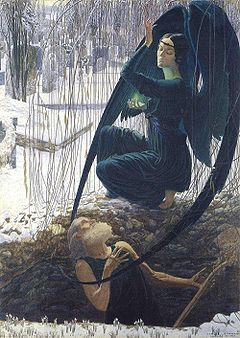
Carlos Schwabe
Encyclopedia

Symbolism (arts)
Symbolism was a late nineteenth-century art movement of French, Russian and Belgian origin in poetry and other arts. In literature, the style had its beginnings with the publication Les Fleurs du mal by Charles Baudelaire...
painter and printmaker.
Schwabe was born in Altona
Altona, Hamburg
Altona is the westernmost urban borough of the German city state of Hamburg, on the right bank of the Elbe river. From 1640 to 1864 Altona was under the administration of the Danish monarchy. Altona was an independent city until 1937...
, Holstein
Holstein
Holstein is the region between the rivers Elbe and Eider. It is part of Schleswig-Holstein, the northernmost state of Germany....
, and moved to Geneva
Geneva
Geneva In the national languages of Switzerland the city is known as Genf , Ginevra and Genevra is the second-most-populous city in Switzerland and is the most populous city of Romandie, the French-speaking part of Switzerland...
, Switzerland
Switzerland
Switzerland name of one of the Swiss cantons. ; ; ; or ), in its full name the Swiss Confederation , is a federal republic consisting of 26 cantons, with Bern as the seat of the federal authorities. The country is situated in Western Europe,Or Central Europe depending on the definition....
at an early age. After studying art in Geneva, he relocated to Paris as a young man, where he worked as a wallpaper designer, and he became acquainted with Symbolist artists. His paintings typically featured mythological
Greek mythology
Greek mythology is the body of myths and legends belonging to the ancient Greeks, concerning their gods and heroes, the nature of the world, and the origins and significance of their own cult and ritual practices. They were a part of religion in ancient Greece...
and allegorical
Allegory
Allegory is a demonstrative form of representation explaining meaning other than the words that are spoken. Allegory communicates its message by means of symbolic figures, actions or symbolic representation...
themes; as an essentially literary artist, he was much in demand as a book illustrator
Illustration
An illustration is a displayed visualization form presented as a drawing, painting, photograph or other work of art that is created to elucidate or dictate sensual information by providing a visual representation graphically.- Early history :The earliest forms of illustration were prehistoric...
. He illustrated the novel Le rêve
Le Rêve (novel)
Le rêve is the sixteenth novel in the Rougon-Macquart series by Émile Zola.The novel was published by Charpentier in October 1888 and translated into English by Eliza E. Chase as The Dream in 1893...
(1892) by Emile Zola
Émile Zola
Émile François Zola was a French writer, the most important exemplar of the literary school of naturalism and an important contributor to the development of theatrical naturalism...
, Charles Baudelaire
Charles Baudelaire
Charles Baudelaire was a French poet who produced notable work as an essayist, art critic, and pioneering translator of Edgar Allan Poe. His most famous work, Les Fleurs du mal expresses the changing nature of beauty in modern, industrializing Paris during the nineteenth century...
's Les Fleurs du mal
Les Fleurs du mal
Les Fleurs du mal is a volume of French poetry by Charles Baudelaire. First published in 1857 , it was important in the symbolist and modernist movements...
(1900), Maurice Maeterlinck
Maurice Maeterlinck
Maurice Polydore Marie Bernard Maeterlinck, also called Comte Maeterlinck from 1932, was a Belgian playwright, poet, and essayist who wrote in French. He was awarded the Nobel Prize in Literature in 1911. The main themes in his work are death and the meaning of life...
's Pelléas et Mélisande
Pelléas et Mélisande (play)
Pelléas and Mélisande is a Symbolist play by Maurice Maeterlinck about the forbidden, doomed love of the title characters. It was first performed in 1893....
(1892), and Albert Samain
Albert Samain
Albert Victor Samain was a French poet and writer of the Symbolist school.Born in Lille, his family were Flemish and had long lived in the town or its suburbs. At the time of the poet's birth, his father, Jean-Baptiste Samain, and his mother, Elisa-Henriette Mouquet, conducted a business in "wines...
's Jardin de l'infante (1908). Schwabe lived in France for the rest of his life and died in Avon, Seine-et-Marne
Avon, Seine-et-Marne
Avon is a commune in the Seine-et-Marne department in the Île-de-France region in north-central France.-Geography:Avon and Fontainebleau, together with three other smaller communes, form an urban area of 36,713 inhabitants...
in 1926.
Two distinct styles are recognized in his art. Before 1900, Schwabe's paintings were more individual and experimental, indicating the idealism of the Symbolists; conventional, allegorical scenes from nature became more prominent in his later work. Images of women were important, sometimes representing death and suffering, other times creativity and guidance. His first wife was his model for angels and virgins, and "Death" in The Death of the Grave-Digger (1895) resembles her. The death of a close friend in 1894, when Schwabe was 28 years old, engendered his interest in representing death.
Schwabe created a colour lithograph for the 1892 Salon de la Rose+Croix, the first of six exhibitions organized by Joséphin Péladan
Joséphin Péladan
Joséphin Péladan was a French novelist and Martinist. His father was a journalist who had written on prophecies, and professed a philosophic-occult Catholicism.-Biography:...
that demonstrated the Rosicrucian
Rosicrucian
Rosicrucianism is a philosophical secret society, said to have been founded in late medieval Germany by Christian Rosenkreuz. It holds a doctrine or theology "built on esoteric truths of the ancient past", which, "concealed from the average man, provide insight into nature, the physical universe...
tendencies of French Symbolism. Schwabe's poster depicted in shades of blue an initiation rite—three women ascending toward spiritual salvation—and is an exemplar of Rosicrucian art.

